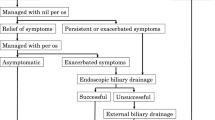Abstract
Transhepatic cholangiography (THC) was performed in 107 patients who had nondilated intrahepatic bile ducts on computed tomography (CT) or ultrasound. The cholangiogram was diagnostic in 72 patients (67%). Thirty-one (43%) of the 72 diagnostic studies were abnormal and showed poor emptying, stones, or strictures. Twenty-three (21%) complications occurred, including two deaths. Sixteen patients experienced acute pain, requiring additional narcotics. There was one case of peritonitis and pancreatitis, and two of bacteremia. We compared our success and complication rates to those of endoscopic retrograde cholangiography (ERC) reported in the literature.
We conclude that when a bile duct abnormality is clinically suspected, the incidence of pathology is sufficiently high to warrant direct visualization of the ducts in order to make an anatomic diagnosis, even if the intrahepatic ducts are not dilated. However, ERC has a better success rate and fewer complications than THC and it should be the initial invasive procedure.
Similar content being viewed by others
References
Wolcott JK, Chen PS. Radiologic evaluation of the jaundiced patient: diagnostic and therapeutic role of current procedures.Radiol Eval 1988; 84:233–246
Cronan JJ. The imaging of biliary obstruction.Semin Ultrasound CT MRI 1984; 5:376–398
Juttijudata P, Palavatana C, Chiemchaisri C, Churnratanakul S. The accuracy of percutaneous transhepatic cholangiography (PTC) using the Chiba needle in the diagnosis of level and cause of cholestasis.Australas Radiol 1986; 30:24–29
Harbin WP, Mueller PR, Ferrucci JT. Transhepatic cholangiography: complications and use patterns of the fine-needle technique.Radiology 1980; 135:15–22
Muhletaler CA, Gerlock AJ, Fleischer AC, James AE Jr. Diagnosis of obstructive jaundice with nondilated bile ducts.AJR 1980; 134:1149–1152
Juttijudata P, Palavatana C, Chiemchaisri C, Churnratanakul S. Percutaneous transhepatic cholangiography with the Chiba needle in patients with biliary calculi.Radiology 1983; 146:643–645
Elias E, Hamlyn AN, Jain S, et al. Liver physiology and disease: a randomized trial of percutaneous transhepatic cholangiography with the Chiba needle versus endoscopic retrograde cholangiography for bile duct visualization in jaundice.Gastroenterology 1976; 71:439–443
Elias E. Progress report: cholangiography in the jaundiced patient.Gut 1976; 17:801–811
Ginestal-Cruz A, Pinto-Correia J, Camilo E, Grima N, Cardoso A, Baptista A, et al. Combined approach to the differential diagnosis of cholestatic jaundice with endoscopic retrograde cholangiopancreatography, percutaneous transhepatic cholangiography, ultrasonography, and liver biopsy.Gastrointest Radiol 1981; 6:177–183
Bilbao MK, Dotter CT, Lee TG, Katon RM. Complications of endoscopic retrograde cholangiopancreatography (ERCP).Gastroenterology 1976; 70:314–320
Kullman E, Borch K, Tarpila E, Liedberg G. Endoscopic retrograde cholangiopancreatography (ERCP) in patients with jaundice and suspected biliary obstruction.Acta Chir Scand 1984; 150:657–663
Tobin RS, Vogelzang RL, Gore RM, Keigley B. A comparative study of computed tomography and ERCP in pancreaticobiliary disease.CT 1987; 11:261–266
Chang-Chien CS. Do juxtapapillary diverticula of the duodenum interfere with cannulation at endoscopic retrograde cholangiopancreatography?Gastrointest Endosc 1987; 33:298–300
Jander HP, Galbraith J, Aldrete JS. Percutaneous transhepatic cholangiography using the Chiba needle: comparison with retrograde pancreatocholecystography.South Med J 1980; 73:415–421
Lai ECS, Lo CM, Choi TK, Cheng WK, Fan ST, Wong J. Urgent biliary decompression after endoscopic retrograde cholangiopancreatography.Am J Surg 1989; 157:121–125
Reiertsen O, Skjoto J, Jacobsen CD, Rosseland AR. Complications of fiberoptic gastrointestinal endoscopy — five years' experience in a central hospital.Endoscopy 1987; 19:1–6
Lunderquist A. The radiology of jaundice.Baillieres Clin Gasteroenterol 1989; 3:387–407
Brandes JW, Scheffer B, Lorenz-Meyer H, Korst HA, Littmann KP. ERCP: Complications and prophylaxis. A controlled study.Endoscopy 1981; 13:27–30
Roszier MH, Campbell WL. Post-ERCP pancreatitis: association with urographic visualization during ERCP.Radiology 1985; 157:595–598
Author information
Authors and Affiliations
Rights and permissions
About this article
Cite this article
Teplick, S.K., Flick, P. & Brandon, J.C. Transhepatic cholangiography in patients with suspected biliary disease and nondilated intrahepatic bile ducts. Gastrointest Radiol 16, 193–197 (1991). https://doi.org/10.1007/BF01887344
Received:
Accepted:
Issue Date:
DOI: https://doi.org/10.1007/BF01887344




